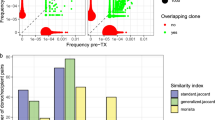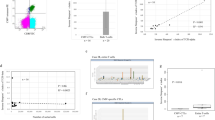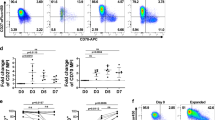Abstract
In addition to its established hematological indications, autologous hematopoietic SCT (HSCT) can ameliorate the course of severe autoimmune disorders through a reconditioning of the immune system. We have shown earlier that HSCT determines extensive renewal of the TCR repertoire in multiple sclerosis patients. However, the observed persistence post-therapy of some pre-existing T-cell clones suggested the potential for disease recapitulation. Here, we investigated whether TCRs that reappear after a myeloablative conditioning regimen and HSCT were reintroduced with the autologous, CD34-selected hematopoietic stem cell (HSC) graft. In all, we cloned and sequenced 2237 TCR clones from peripheral blood and HSC grafts from four patients who underwent autologous HSCT for severe multiple sclerosis. Surprisingly, in-frame TCR sequences were detectable in only one of four patient grafts and no TCR sequences were found to be shared between the graft and pre- or post-HSCT samples. These findings provide the first evidence from extensive sequencing analysis to suggest that T cells in autologous HSC grafts that have been mobilized with CY+G-CSF and CD34-selected have limited survival capacity and are therefore unlikely to be a major source of carryover of T-cell expansions potentially involved in autoimmune disease.
This is a preview of subscription content, access via your institution
Access options
Subscribe to this journal
Receive 12 print issues and online access
$259.00 per year
only $21.58 per issue
Buy this article
- Purchase on Springer Link
- Instant access to full article PDF
Prices may be subject to local taxes which are calculated during checkout



Similar content being viewed by others
References
Sykes M, Nikolic B . Treatment of severe autoimmune disease by stem-cell transplantation. Nature 2005; 435: 620–627.
Muraro PA, Douek DC, Packer A, Chung K, Guenaga FJ, Cassiani-Ingoni R et al. Thymic output generates a new and diverse TCR repertoire after autologous stem cell transplantation in multiple sclerosis patients. J Exp Med 2005; 201: 805–816.
de Kleer I, Vastert B, Klein M, Teklenburg G, Arkesteijn G, Yung GP et al. Autologous stem cell transplantation for autoimmunity induces immunologic self-tolerance by reprogramming autoreactive T cells and restoring the CD4+CD25+ immune regulatory network. Blood 2006; 107: 1696–1702.
Burt RK, Marmont A, Oyama Y, Slavin S, Arnold R, Hiepe F et al. Randomized controlled trials of autologous hematopoietic stem cell transplantation for autoimmune diseases: the evolution from myeloablative to lymphoablative transplant regimens. Arthritis Rheum 2006; 54: 3750–3760.
Openshaw H, Lund BT, Kashyap A, Atkinson R, Sniecinski I, Weiner LP et al. Peripheral blood stem cell transplantation in multiple sclerosis with busulfan and cyclophosphamide conditioning: report of toxicity and immunological monitoring. Biol Blood Marrow Transplant 2000; 6: 563–575.
Ni XS, Ouyang J, Zhu WH, Wang C, Chen B . Autologous hematopoietic stem cell transplantation for progressive multiple sclerosis: report of efficacy and safety at three yr of follow up in 21 patients. Clin Transplant 2006; 20: 485–489.
Nash RA, Bowen JD, McSweeney PA, Pavletic SZ, Maravilla KR, Park MS et al. High-dose immunosuppressive therapy and autologous peripheral blood stem cell transplantation for severe multiple sclerosis. Blood 2003; 102: 2364–2372.
Nash RA, Dansey R, Storek J, Georges GE, Bowen JD, Holmberg LA et al. Epstein-Barr virus-associated posttransplantation lymphoproliferative disorder after high-dose immunosuppressive therapy and autologous CD34-selected hematopoietic stem cell transplantation for severe autoimmune diseases. Biol Blood Marrow Transplant 2003; 9: 583–591.
Samijn JP, te Boekhorst PA, Mondria T, van Doorn PA, Flach HZ, van der Meche FG et al. Intense T cell depletion followed by autologous bone marrow transplantation for severe multiple sclerosis. J Neurol Neurosurg Psychiatry 2006; 77: 46–50.
Burt RK, Cohen BA, Russell E, Spero K, Joshi A, Oyama Y et al. Hematopoietic stem cell transplantation for progressive multiple sclerosis: failure of a total body irradiation-based conditioning regimen to prevent disease progression in patients with high disability scores. Blood 2003; 102: 2373–2378.
Muraro PA, Jacobsen M, Necker A, Nagle JW, Gaber R, Sommer N et al. Rapid identification of local T cell expansion in inflammatory organ diseases by flow cytometric T cell receptor Vbeta analysis. J Immunol Methods 2000; 246: 131–143.
van Dongen JJ, Langerak AW, Bruggemann M, Evans PA, Hummel M, Lavender FL et al. Design and standardization of PCR primers and protocols for detection of clonal immunoglobulin and T-cell receptor gene recombinations in suspect lymphoproliferations: report of the BIOMED-2 Concerted Action BMH4-CT98-3936. Leukemia 2003; 17: 2257–2317.
Packer AN, Muraro PA . Optimized clonotypic analysis of T-cell receptor repertoire in immune reconstitution. Exp Hematol 2007; 35: 516–521.
Pette M, Gold R, Pette DF, Hartung HP, Toyka KV . Mafosfamide induces DNA fragmentation and apoptosis in human T-lymphocytes. A possible mechanism of its immunosuppressive action. Immunopharmacology 1995; 30: 59–69.
Strauss G, Westhoff MA, Fischer-Posovszky P, Fulda S, Schanbacher M, Eckhoff SM et al. 4-hydroperoxy-cyclophosphamide mediates caspase-independent T-cell apoptosis involving oxidative stress-induced nuclear relocation of mitochondrial apoptogenic factors AIF and EndoG. Cell Death Differ 2007; 15: 342–343.
Kalina T, Lu H, Zhao Z, Blewett E, Dittmer DP, Randolph-Habecker J et al. De novo generation of CD4 T cells against viruses present in the host during immune reconstitution. Blood 2005; 105: 2410–2414.
Arstila TP, Casrouge A, Baron V, Even J, Kanellopoulos J, Kourilsky P . A direct estimate of the human alphabeta T cell receptor diversity. Science 1999; 286: 958–961.
Moore J, Brooks P, Milliken S, Biggs J, Ma D, Handel M et al. A pilot randomized trial comparing CD34-selected versus unmanipulated hemopoietic stem cell transplantation for severe, refractory rheumatoid arthritis. Arthritis Rheum 2002; 46: 2301–2309.
Mohty M . Mechanisms of action of antithymocyte globulin: T-cell depletion and beyond. Leukemia 2007; 21: 1387–1394.
Cox AL, Thompson SA, Jones JL, Robertson VH, Hale G, Waldmann H et al. Lymphocyte homeostasis following therapeutic lymphocyte depletion in multiple sclerosis. Eur J Immunol 2005; 35: 3332–3342.
Mancardi G, Saccardi R . Autologous haematopoietic stem-cell transplantation in multiple sclerosis. Lancet Neurol 2008; 7: 626–636.
Burt RK, Loh Y, Cohen B, Stefoski D, Balabanov R, Katsamakis G et al. Autologous non-myeloablative haemopoietic stem cell transplantation in relapsing-remitting multiple sclerosis: a phase I/II study. Lancet Neurol 2009; 8: 244–253.
Acknowledgements
We thank JW Nagle and D Kauffman (NINDS DNA sequencing facility) for the outstanding sequencing support, and D Carassiti for technical assistance. We also thank D Douek for helpful suggestions and for providing oligonucleotide primers, and S Gagnon and B Biddison for providing the plasmids, Q334 and F6. This work was supported by the intramural NINDS program of the National Institutes of Health (AND, RM, PAM). PAM is also grateful for support from the NIHR Biomedical Research Centre funding scheme and the Hammersmith Hospital Research Trustees Committee (Ref. No. 70159).
Author information
Authors and Affiliations
Corresponding author
Rights and permissions
About this article
Cite this article
Dubinsky, A., Burt, R., Martin, R. et al. T-cell clones persisting in the circulation after autologous hematopoietic SCT are undetectable in the peripheral CD34+ selected graft. Bone Marrow Transplant 45, 325–331 (2010). https://doi.org/10.1038/bmt.2009.139
Received:
Revised:
Accepted:
Published:
Issue Date:
DOI: https://doi.org/10.1038/bmt.2009.139
Keywords
This article is cited by
-
Post Transplantation Cyclophosphamide Improves Outcome of Autologous Hematopoietic Stem Cell Transplantation in Animal Model of Multiple Sclerosis
Archivum Immunologiae et Therapiae Experimentalis (2021)
-
Autologous haematopoietic stem cell transplantation for treatment of multiple sclerosis
Nature Reviews Neurology (2017)
-
Haematopoietic stem cell transplantation for autoimmune diseases
Nature Reviews Rheumatology (2017)
-
Autologous hematopoietic stem cell transplantation in multiple sclerosis: 20 years of experience
Neurological Sciences (2016)
-
Autologous Bone Marrow Transplantation for the Treatment of Multiple Sclerosis
Current Neurology and Neuroscience Reports (2014)



